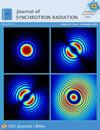ALS-ENABLE: creating synergy and opportunity at the Advanced Light Source synchrotron structural biology beamlines.
IF 3
3区 物理与天体物理
Journal of Synchrotron Radiation
Pub Date : 2025-07-01
Epub Date: 2025-06-18
DOI:10.1107/S1600577525004205
引用次数: 0
Abstract
ALS-ENABLE is an integrated NIH P30 resource at the Advanced Light Source synchrotron at Lawrence Berkeley National Laboratory in Berkeley, California, USA. The resource provides a single portal to the combined mature structural biology technologies of macromolecular crystallography, small-angle X-ray scattering and X-ray footprinting mass spectrometry, and includes beamlines 2.0.1, 3.3.1, 4.2.2, 5.0.1, 5.0.2, 5.0.3, 8.2.1, 8.2.2, 8.3.1 and 12.3.1. This paper describes the organizational structure and the technologies of ALS-ENABLE. A case study showcasing the main technologies of the resource applied to the characterization of the SpyCatcher-SpyTag protein system is presented.
ALS-ENABLE:在先进光源同步加速器结构生物光束线上创造协同作用和机会。
ALS-ENABLE是美国加州伯克利劳伦斯伯克利国家实验室先进光源同步加速器的集成NIH P30资源。该资源为结合大分子晶体学、小角度x射线散射和x射线足迹质谱等成熟结构生物学技术提供了单一门户,包括光束线2.0.1、3.3.1、4.2.2、5.0.1、5.0.2、5.0.3、8.2.1、8.2.2、8.3.1和12.3.1。本文介绍了ALS-ENABLE的组织结构和技术。一个案例研究展示了该资源的主要技术应用于SpyCatcher-SpyTag蛋白系统的表征。
本文章由计算机程序翻译,如有差异,请以英文原文为准。
求助全文
约1分钟内获得全文
求助全文
来源期刊

Journal of Synchrotron Radiation
INSTRUMENTS & INSTRUMENTATIONOPTICS&-OPTICS
CiteScore
5.60
自引率
12.00%
发文量
289
审稿时长
1 months
期刊介绍:
Synchrotron radiation research is rapidly expanding with many new sources of radiation being created globally. Synchrotron radiation plays a leading role in pure science and in emerging technologies. The Journal of Synchrotron Radiation provides comprehensive coverage of the entire field of synchrotron radiation and free-electron laser research including instrumentation, theory, computing and scientific applications in areas such as biology, nanoscience and materials science. Rapid publication ensures an up-to-date information resource for scientists and engineers in the field.
 求助内容:
求助内容: 应助结果提醒方式:
应助结果提醒方式:


